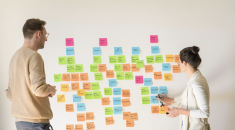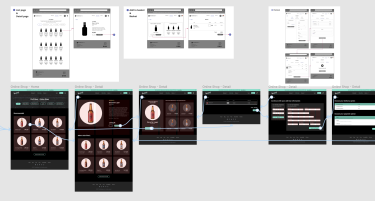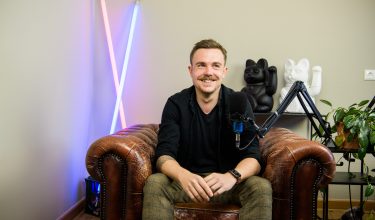
#customer-journey #user research #service design & concept
07. Dez. 2022 |
- min Lesezeit
Being a Service Designer means jumping from strategic thinking to details of a concept within a blink of an eye, which makes it really hard to provide an insight into a “typical day”.
The work is both structuring and creative, which means being able to break out of given structures as well.
It requires, in my opinion, a healthy mix of fact-based, creative, pragmatic, and solution-oriented work with the ability to use a range of hand-picked tools. What may sound like a very complex and strenuous work context at first, is actually a lot of fun. There are so many new things to discover and learn every day.
Boredom, at least, is not part of the job description, I can promise. So, here I am, trying to show you one typical day among many atypical days.

Usually, my day starts around 8:00 am—as soon as I forgive my alarm for interrupting my beauty sleep. Once I consider myself more or less awake, I go for a morning walk around the neighbourhood to catch energy for the day and breathe some fresh air. Afterwards, I check my calendar and inbox to plan my day. If I am working from home, the time has come to be a Service Designer at DieProduktMacher (DPM). Otherwise, I jump on my bike, which I leased through DPM, and ride to the office.
Most of the people working at DPM start around 9am, which means it’s the perfect time for all the various daily, weekly, or bi-weekly meetings with your DPM teammates or with your project teams on the client’s side. On a Monday morning, for example, the whole Service Design & Concept team meets to discuss the weekend and what’s going on this week, if someone needs support or has support to offer. Right after this meeting, I check what my different projects are doing by huddling in the daily standups.
Right after the more organizational start into the day, there’s plenty of time to focus and get things done! But before we get technical, let’s clarify what it means to be a Service Designer. “Designing a service” (even if the NN/g defines a difference to Service Design) sounds like many processes at first. For me, designing a service, product or feature is always about the people behind it. Service design is first and foremost a “people business”, which always involves a lot of communication. When it comes to understanding more complex issues, I rely on the expertise of various people, which I try to tap into as much as possible.
The most typical project to work on as a service designer at DPM involves the discovery process in its entirety. This means that I am responsible for structuring and steering a project in an early product development phase by selecting and implementing the right methodology. Let’s flesh this out a bit: We get requests from our clients to design a largely undefined product or service based on market, customer, and desk research. This means that I am either in the process of structuring the available assumptions in a hypothesis backlog, prioritizing them with the customer, or deriving validation measures from them. As a rule, however, we very often recommend involving customer voices in order to also further open up the space for possible solution approaches. Here’s a good read about a discovery project we did with Freepik.
One of our favourite tools to uncover potential problems for our clients or their customers is the Customer Journey Workshop. We use it to analyze which tasks an end customer has, which different touchpoints they come into contact with, and where problems or expectations arise along this journey.
This all serves to minimize risk and to evaluate where there are currently customer problems and therefore optimization potential - either by improving existing products/services or by creating new ones.
Wow, that was already quite a lot. Time to tackle the most important question of the day:
What do we eat for lunch?

Usually, individual groups are formed, which go in different culinary directions. Starting with Thai cuisine, through the classic bakery or butchery to kebab or pizza. But what they all have in common is that they ultimately end up back at the big dining table in the DPM kitchen and eat together. And so do I, after opting today for a beet and cream cheese bagel from our bakery around the corner.
On rare occasions, we even have volunteer cooks who team up to prepare dishes such as hot dogs, tacos, bowls, or others.


Let’s assume we have understood the client’s current situation and know what the problems are for them and their customers. Based on that, we have to find ways how things could be done better. I’m purposely phrasing this in the subjunctive because we’re primarily guessing how things could get better. This is where another round of validation begins - a step called problem-solution fit, meaning we need to verify that the solution approach we propose actually solves the problem we originally identified.
There are many different approaches, but my favourite and the process we typically use at DPM looks like this:
Start with roughly sketched solution ideas using ideation methods such as how-might-we-guided brainstorming or brainwriting, Crazy8, and others. Here, it’s very important that quantity wins out over quality. This often feels wrong to people. Why should I write down obviously stupid ideas that won’t be implemented in a thousand years? In my opinion, there are two reasons: inspiration and fun. I’m a big fan of sharing funny or goofy ideas because it inspires others to think beyond them. It helps to get into new perspectives and go beyond the ideas that are apparent anyway. Quantity wins out over quality also means that ideally, you will have generated more solution ideas than you can implement. That’s why our good friend “prioritization” needs to greet us as often as necessary. Select your prioritized or simply favorite ideas and use them for a validation round with users or potential users.
Of course, in order to test our ideas with users, we need to be able to communicate them somehow. That’s why it’s the perfect time to start visualizing our ideas. A method to start with is the so-called wireframing. When creating wireframes (meaning first visualizations without details like final texts or designs) we already think about first dependencies, difficulties, improvements, or extensions to develop our rough solution ideas into mature concepts.
Digital products typically include some sort of interaction and are in the fewest cases something static, like wireframes. To breathe life into our static visualizations, we use Figma. There you can decide what should happen when a user clicks on a certain button or performs a certain swipe gesture. So, it already feels like a real product without having to write a single line of code.

Pssst…I can highly recommend checking out the Digital Log episode with my colleague Simon. It’s called Fantastic Prototypes and where to find them (and yes, we love puns). Basically, it’s about the process of building a prototype and which opportunities they can offer.
Because I enjoy working with my colleagues at DPM, I like to involve them on a regular basis, especially to get their feedback. Proper feedback can often take results to the next level. That’s why we put a lot of emphasis on giving feedback and, more importantly, on how to give it properly.
So, the final step to fine-tune our prototype is to implement the feedback and prepare everything for user testing. We’re done for today, we analysed potential problems, generated ideas on how to solve them, and created a shiny prototype for validating those.

I’ve already mentioned how fun the team spirit is and that it’s great to work in this team - if you want to find out more first-hand, you’re in good hands with our Kununu reviews.
What I’m saying is that thanks to the friendly atmosphere, there’s a lot going on after work as well. Many initiatives are started directly by the employees, and there is something for almost everyone. From the classic after-work beer from the fridge to the not-so-classic after-work beer from the company’s own tap to various sports groups such as ice skating, soccer, bouldering, yoga, road biking, hiking, workation, and much more.
One thing I have learned in the last five years at DieProduktMacher, everything is possible if you bring enthusiasm and show initiative. This is exactly how the workations in Barcelona or Stockholm have been organized by smaller groups this year or in the first years of DPM our surf offices in Spain.
Interested? Then take a look at our current job postings, and if there is something for you, we look forward to receiving your application.
